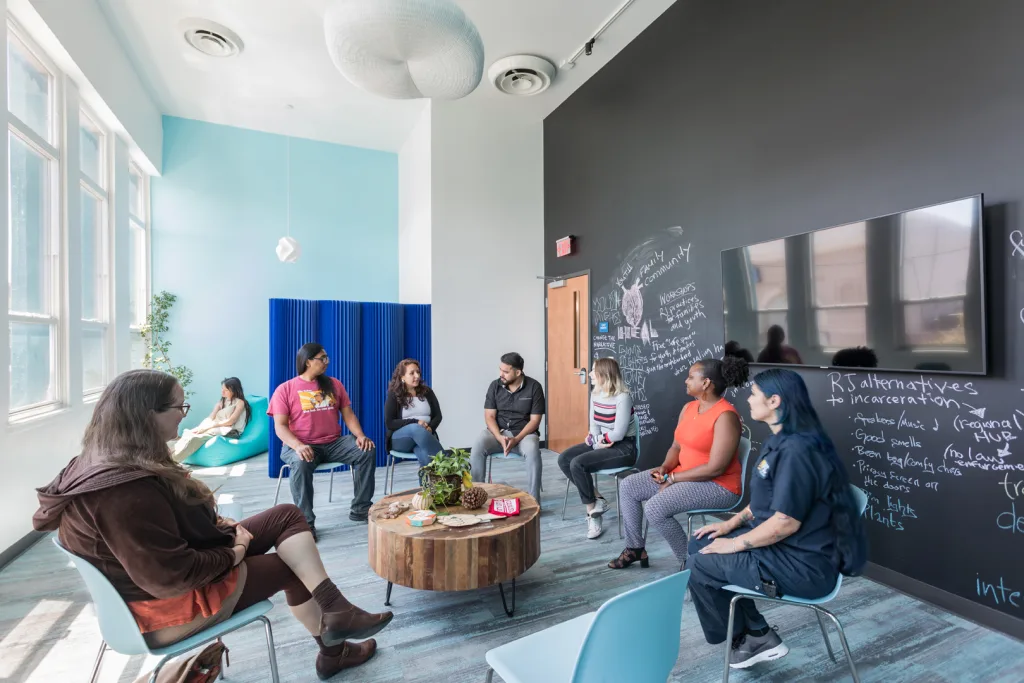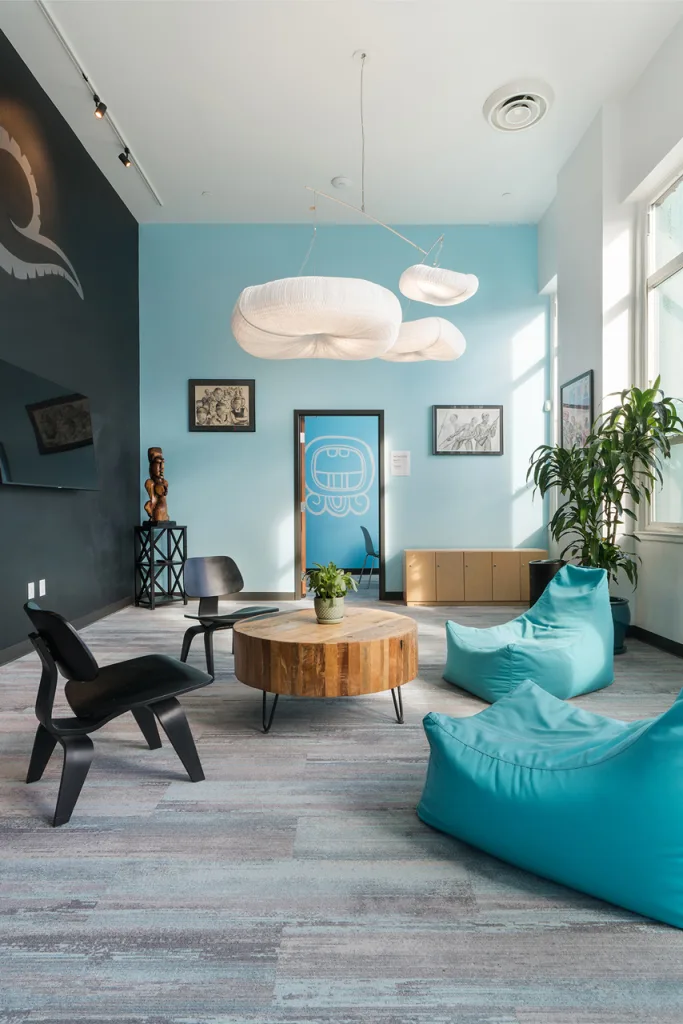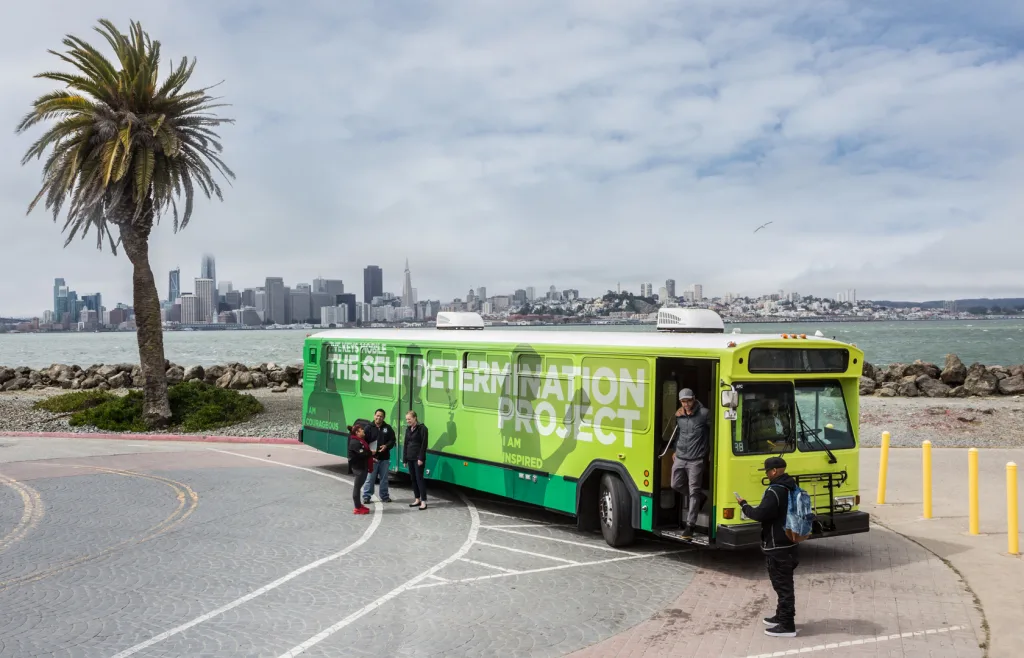On a recent afternoon, Deanna Van Buren lead me through a thought exercise over Zoom. “Close your eyes,” she said through the screen. “And think of a courthouse. What do you see?”
“You probably see security, hard, institutional surfaces; there’s not a lot of texture, almost no natural light.” She goes on to list what else is missing, from windows that look out at nature to food or private spaces. “There’s nothing that takes care of the mind,” she continues. “It’s very much designed for the tenants and values of that system.”
Van Buren was referring to the criminal legal system and the spaces it relies on to purportedly ensure justice—namely, prisons, jails, courthouses, and detention centers. The architect has been questioning society’s historical take on justice through her design firm Designing Justice + Designing Spaces (DJDS), which seeks to end mass incarceration through architecture.
“What we’re doing doesn’t work. It’s very expensive and it’s actually perpetuating harm,” she says of the U.S.’ current strategy for responding to crime. “They use the same plans to build these jails and prisons…whereas a million solutions need to be created [that are] more localized or place-based.”
A new vision for justice
DJDS’ vision is based on principles of abolition and what’s called “restorative justice.” This movement aims to replace punitive structures (e.g. prisons and jails) with programs and spaces that tackle the root cause of harm caused—financial, emotional, relational, or otherwise. Instead of confining someone for a crime they commit, DJDS and its partners believe in responding with mental healthcare, gainful employment, community accountability, substance abuse support, and whatever other resources are needed for all parties to feel restored.
Van Buren designed her first concept when she was five years old. Her school in rural Virginia had sent her home for punching a kid in the face. He had called her the N-word, and she was justifiably angry and scared. “I would run into the forest and build these little huts made out of twigs and leaves, and blankets I had taken from my mom,” she shared in her 2017 TED Talk. “As the light would stream into my refuge, I felt at peace.” These “healing huts” depict Van Buren’s first experience building a space that was meant to restore, to return her to a sense of calm after conflict. Decades later, she’s applying this same approach to entire community systems.
The idea that physical spaces can be an outlet for restorative justice is what sets Van Buren’s work apart. Be it healing huts or campuses dedicated to reentry, DJDS is making a concept like restorative justice—one that many claim is too utopic or even a bit jargony—more tangible. She is rooting the idea of a world without prisons, jails, and other channels for confinement in actual space.
A bigger purpose for architecture
Since its founding in 2017, DJDS has partnered on dozens of projects and has purchased real estate for their own developments to design spaces that reimagine what real public safety looks like. Take, for instance, the Peace Room the firm designed with Restore Oakland, a nonprofit resource and program hub that its Executive Director Tash Nguyen describes as a “community safety laboratory.”
Restore Oakland wanted a space to work through conflict. The organization often hold “circles”—a practice common in abolitionist company where, in some cases, people who have committed harm come together with people who have survived it to process life events and traumas. To build a space conducive to these conversations, DJDS’ started with a participatory design process that asked community members what colors, furniture, or resources they envisioned when they thought of healing. What did they need in order to feel taken care of while working through potentially difficult conversations?

Members cited “a sense of lightness, the feeling of reaching toward the sky, and a place rooted in neighborhood culture,” Nguyen shares. Consequently, the Peace Room is on the top floor, covered in blues and purples, overhead lights that mimic clouds, and various plushy chairs.
“We’ve done a lot of research on trauma-informed practices and how they translate into actual spaces,” Van Buren says. “You’re going to see objects of comfort—things you want to see, touch, or hear, like biophilia, the inclusion of natural elements, soft furnishings and finishes, things that people can hold like pillows, art that reflects the people who will be in the space, food, translucent doors so people can see through the room, and very clear indications of what is going to happen where.”
The Peace Room is intentionally next to bathrooms and “cool off spaces” where, if needed, circle participants can go for refuge. The room itself has two entrances so that folks participating in circles feel they can enter or exit the conversation at any time, separately and on their own volition.
It’s only by removing carceral visual cues—chains, locks, bars, confusing hallways, hospital-like lighting, concrete gray walls—and embracing a sense of calm, that DJDS and its partners argue the real justice work can begin. Van Buren shares that spaces like Restore Oakland’s can serve as a community staple, one that makes the process of justice more digestible to residents. “We go to classrooms to learn, why not have spaces to do justice?” Van Buren asks. “Why can’t it be ‘oh there’s the library where we study, and there’s the restorative justice center where we address conflict?”
Restore Oakland has become “a place of real belonging [and] where people can experience accountability in real time,” says Nguyen. “If we’re able to create room for people to apologize, come clean, name [their] needs, and actually support each other— through these smaller instances of harm, we can prevent violence.”

Nguyen describes a recent example where a local business owner called Restore Oakland after a former, long-time employee had stolen $300. The business owner didn’t want to involve the cops, but they were hurt and wanted to rectify the situation. Two weeks later, both parties found themselves circled up in the Peace Room, the Restore Oakland facilitator asking what justice looked like for everyone and how to make things right for all involved.
They discovered that, recently let go, the former employee didn’t have the cash to make rent and he was really in need of housing stability. Together, they worked through his apology and the shopkeeper communicated what repair was needed. They also devised a plan to secure the former employee housing vouchers (the former employer even provided job references). Unlike the courtroom, this was a space where people who have committed harm feel they can be honest, which creates more stability, accountability, and care for everyone.
For Leonard Brown, a long-time attendee of Restore Oakland’s circle groups, the value of the practice comes from the simple act of being able to share. “In prison, most guys—regardless of the situation—they want to just be heard,” he says. “Some people come in [to circles] heavy, some people come in light. And that space is there to hold you, to celebrate you, to uplift you.”
Incarceration’s insistence on “rehabilitation” suggests we must “fix” individuals that commit harm versus tackling the systems that have created hostile conditions in the first place. “Restore means it’s not lost, it’s not gone away,” Brown says. Restoration, he insists, allows people to “be the best version of themselves.”

Building new prototypes
Through its work, DJDS is also building blueprints and prototypes that communities can invest in and tweak depending on their specific needs. Concepts like “School on Wheels” or Mobile Refuge Rooms are spaces that serve as community infrastructure without depending on police, incarceration, and other systems of oppression that disproportionately impact people of color.
For example, DJDS worked with Building Opportunities for Self-Sufficiency to conceptualize the Mobile Refuge Room, which support people coming home from prison. The rooms, currently in prototype phase, are primarily intended for program providers (e.g. nonprofit or government) who can cluster the units in varying configurations alongside wraparound services. Currently, a Mobile Refuge Room lives at an East Oakland reentry facility, where it acts as transitional housing for people who recently left prison (this can last from six to 18 months). Individuals have cycled in and out of it since January of 2020.
The current Mobile Refuge Room features a murphy bed and other movable furniture in response to community designers who, having lived in facilities that deter camaraderie and interaction with loved ones, wanted space to host guests in their room. “Part of our work is to activate local messengers to be active participants, versus spectators of the built environment within their community,” says Brandi Mack, DJDS’ Director of Community Engagement.
Under Mack’s guidance, DJDS started a Community Activators Board, where they compensate local leaders and people with lived experience as project partners and consultants. “If you include everybody in the beginning, you don’t need no equity and diversity [board],” she says.

The Mobile Refuge Rooms is a response to the need for more reentry housing that also ensures privacy and dignity for folks coming home. Van Buren says engaging people recently home from carceral facilities as co-designers informed the resulting form. “We originally had [the rooms] on casters so we could move them around,” she shares. “Folks said ‘no, we need to feel solid, we need to psychology feel like when we come back you can’t move our rooms.’”

Restoration in real time
Like any architectural space, many of DJDS’ designs take time to bring to life. But one of the studio’s oldest projects, Pop Up Village, aims to have impact in real time. The experience is like a community oriented farmer’s market or retail store designed to create pockets of commerce and community support in areas that lack access. The idea stemmed from the understanding that brick and mortar development, like Restore Oakland, takes time; in the meantime, communities have immediate needs that must be addressed.
Managed by local event nonprofit Compass & Keys, the collective combines free fresh produce and recipes, doulas, sonogram and acupuncture buses, and local retail businesses. Together, it serves as “a mobile infrastructure tool to elevate blighted communities while providing real resources,” as Mack describes it. DJDS’ design ranges from buses converted into therapy intake trailers to moveable, multi-sized market stalls where barbers and DJs can plug in, or new moms can receive a belly massage.
DJDS is constantly evolving the space based on community needs. Its most recent iteration, for instance, centers Black pregnant mothers. This evolution has served over 2,120 people, over 230 of whom are pregnant women, with over 140 service providers.

“We’re bridging a gap between impacted communities and the systems we’ve been taught not to trust,” says Jean-Paul Zapata, DJDS’ Director of Communications. “Modular architecture is a universal blank slate that gets enriched and informed by the community it’s in.”
KaSelah Crocket, who oversees all aspects of the Village, formerly worked in youth mental health and family services. She says the Pop Up village is truly emblematic of what preventative, multi-generational care looks like. “I’ve seen what we do with children and families on the other end,” she says of her work responding to the foster care system. “I’ve been a part of that ‘solution’—I’ve lined kids up for meds—and that ain’t it.”

Ultimately, Van Buren and DJDS’ partners are asking us to consider what it could look like to build entirely new and effective solutions that take care of every human involved. Instead of investing in national Cop City projects or increased subway security with bag checking policies that mimic harmful stop and frisk laws, they’re asking a different set of questions. If we had the imagination to create prisons, why not have the imagination for something else? Because, as Van Buren says, “We can make these other [solutions] just as easily as we have built these cages.”
